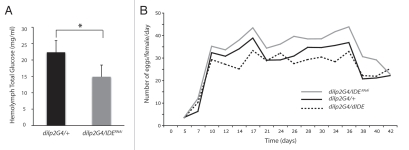Figure 2.
IDE is important for circulating sugar level and fecundity. (A) Hemolymph total glucose, derived mostly from trehalose and representing ≤1% free glucose, was about 30% lower for flies in which Ide RNAi was activated with the dilp2-Gal4 driver (dilp2G4/IDERNAi) when compared to the control (dilp2G4/+). *p = 0.0127, one-tailed t-test. The circulating sugar level was not determined for IDE overexpressing flies. (B) Using the dilp2-Gal4 driver to activate Ide RNAi (dilp2G4/IDERNAi) or IDE overexpression (dilp2G4/dIDE) in IPCs resulted in flies with increased and decreased fecundity, respectively, compared to control flies (dilp2G4/+). Eggs laid by individual virgin females were counted, with a plot showing the average of data from 50–60 females per genotype minus any flies that died during the experiment. The dilp2G4/+, dilp2G4/IDERNAi and dilp2G4/dIDE females, respectively, laid per female an average of about 1,090, 1,250 and 970 eggs over 39 days, or about 28, 32 and 25 eggs per day. Preliminary experiments with mated females showed similar results.

